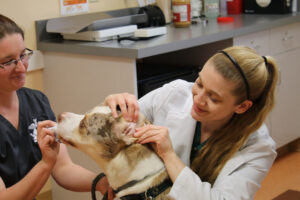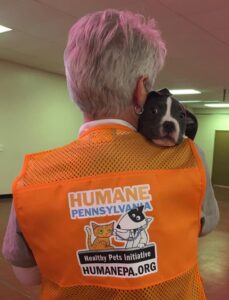By: Suzanne D’Alonzo, Community Outreach Programs Manager
At your last regular doctor’s visit for a check-up, were you asked if you exercise? Smoke? Even if you wear a helmet while you bike? If your doctor is looking to help you stay in top working order, sure, they see what childhood diseases you might have been vaccinated against, but they also focus on some of the other things that keep you healthy. Much of good medical care is about prevention.
The Drive-in Vaccination Clinics of our Healthy Pets Initiative offer important vaccinations to pets in our community that otherwise might not have access to them. That’s great, because pets who avoid illness from disease have a better chance of a long, healthy life.
Yet these Drive-in Vaccination Clinics also focus on prevention, much like your doctor’s visit. We offer microchips. Microchips can be the ticket home for lost pets, and that’s as valuable as vaccination!
Microchips are about the size and shape of a grain of rice, can go in a pet as tiny as a kitten, and have no ill-effects. A pet who gets chipped will have that chip last their lifetime.
Bear with an oversimplification: if you think about how a barcode on, say, a box of cereal works, it’s really just ink on paper. It doesn’t “do” anything, but a scanner can read and “translate” that zebra pattern into information at check out. Each product bar code pattern is different, and each has specific info that goes with it. That’s how the cash register ends up translating “zebra stripes” to “box of Cheerios, $1.99.”
Bear with a rough comparison: a microchip that has been implanted in a pet works much like the barcode on a cereal box in the sense that it’s not “doing” anything until it’s scanned, and scanning holds the key to more information.
Each chip has a unique identification number connected to it. That number pops up when a lost pet is scanned with a microchip scanner. A shelter, rescue, veterinarian’s office, or the finder of a pet that has taken the pet to be scanned at one of these locations is able to easily and quickly figure out which brand of chip it is, and call that company. The chip company will share what’s been registered in their database for that number- pet’s name, pet owner’s name, phone numbers for the owner, and emergency contact information. The owner gets contacted and if all goes well, the pet is back home in a very short time!
Those of us in animal sheltering regularly hear cat and dog owners say their pets don’t need ID. “He never goes out.” “She always comes when called.” “He wears a collar when we’re outside.” But accidents happen. A door gets left open by visitors. Someone trips on a walk, dropping the leash. A collar is just loose enough when a truck rumbles by. A tree takes out a fence. A meter reader doesn’t close the gate. Even serious emergencies happen- car accidents with pets in the car, EMT crews helping relatives, household fires, rising streams- and pets are often separated from owners in the chaos. Microchipping simply lets us hope for the best and plan for the worst, doing the best to keep pets in the homes that love them.
At our Drive-in Clinics, we can implant a chip quickly- it’s a placed under the scruff of the neck, where there aren’t a lot of nerve endings, with a special tool that works like a needle and syringe that would give a vaccine. And it takes the same time that getting a shot takes! So it’s fast, is only a quick “ouch,” and the chip works immediately. Our team registers the chip for our clients because we know life can get in the way, and a chip without contact information is a dead end for a lost pet.
It’s just as important to share what a chip isn’t: it’s not a GPS-type tracker. There’s no way it can tell you if Fluffy is under the porch three doors down or if Scrappy is headed west on Elm Street. And it’s good to relay that an implanted chip never “runs out” or “gets canceled,” because of the original enrollment plan. Sure, the services that each microchip company offers pet owners may vary and many offer buy-up plans with additional services, but the basic ID will always be there.
Our Healthy Pets Initiative also goes old-school with its preventative measures: we encourage dog and cat owners to rely on microchips in tandem with a collar and identification tag. There’s only an increased chance of pets getting home with these, as someone finding a pet has immediate access to a phone number. That’s good, especially in situations where the finder can’t access a scanner (after-hours or holidays and in cases where transportation is an issue for the finder).
We’re glad we’re able to provide microchips, one of the most practical preventative measures to keep pets safe and in their loving homes. Not only does it make a difference to a lost pet and their family, but a community with a high rate of chipped pets drops its volume of stray animals. Historically, many strays weren’t getting back home. Chipping changes that, creating positive outcomes, and subsequently letting shelters better focus on fewer animals- the ones that don’t already have homes- and stretch out our limited resources.
Not sure if your pet’s microchip info is up to date or registered in your name? Have your pet scanned at your next vet visit and note the number. You can figure out which brand of chip your pet has by using one of the universal pet microchip look-up registries (such as https://www.petmicrochiplookup.org/). Then head to that microchip company’s website and follow their instructions to update information. There is often a small fee to transfer a pet’s information from one owner to another, but updating your own is typically free (that is, there’s usually no cost to change to your new cell number or new address).


 umane Pennsylvania knows that every elected official and every candidate is a potential ally on issues important to our work. That’s why we engage with all of them, regardless of policy affiliation. It turns out donkeys, elephants, and greens all have cats and dogs at home. If ever there was a constituency that crosses party lines, it’s the animals who share our lives. That’s why we have the support of elected officials of all stripes and parties.
umane Pennsylvania knows that every elected official and every candidate is a potential ally on issues important to our work. That’s why we engage with all of them, regardless of policy affiliation. It turns out donkeys, elephants, and greens all have cats and dogs at home. If ever there was a constituency that crosses party lines, it’s the animals who share our lives. That’s why we have the support of elected officials of all stripes and parties. more towards team building. One activity that I facilitated at one of our staff enrichment days, was called “Minefield”. This activity involved a minefield of different objects. We used safety cones, frisbees, crates and anything to create an obstacle. From there I split the group in two and handed each group a blind fold. The objective was to get everyone through the minefield blind folded. The teams could decide to all work together, pair up within the group or potentially have one person lead everyone through the minefield. As a facilitator, I had to change up the course as they were going through and I also noticed that one person from each group stepped up to lead everyone through. So in order to get more involvement within the group I told the ‘leaders’ that they had to remain quiet for a little to encourage other people to step up to guide other people through. Everyone made it through the minefield unscathed.
more towards team building. One activity that I facilitated at one of our staff enrichment days, was called “Minefield”. This activity involved a minefield of different objects. We used safety cones, frisbees, crates and anything to create an obstacle. From there I split the group in two and handed each group a blind fold. The objective was to get everyone through the minefield blind folded. The teams could decide to all work together, pair up within the group or potentially have one person lead everyone through the minefield. As a facilitator, I had to change up the course as they were going through and I also noticed that one person from each group stepped up to lead everyone through. So in order to get more involvement within the group I told the ‘leaders’ that they had to remain quiet for a little to encourage other people to step up to guide other people through. Everyone made it through the minefield unscathed.
 nary Hospital parking lot, but it’s made sense to move them to various locations, just as we did with our original vaccine clinic model. Each new location has the potential to expand our audience, which is just what we want: the more people that know about the Drive-in Clinics, the better! Different spots also mean that we get the chance to create positive new relationships with other businesses and organizations in the community, and that always opens opportunities. For example, we’ll be in the parking lot of Nightclub Reverb for one of the October clinics (thanks, Reverb!). Nightclubs previously had been overlooked, not coming to mind as an obvious shelter or vet hospital connection. This gave us the chance to ask, “why not?!” Their parking lot is a great space for our Drive-in Clinic, plus their neighborhood and their general audience are pet owners too!
nary Hospital parking lot, but it’s made sense to move them to various locations, just as we did with our original vaccine clinic model. Each new location has the potential to expand our audience, which is just what we want: the more people that know about the Drive-in Clinics, the better! Different spots also mean that we get the chance to create positive new relationships with other businesses and organizations in the community, and that always opens opportunities. For example, we’ll be in the parking lot of Nightclub Reverb for one of the October clinics (thanks, Reverb!). Nightclubs previously had been overlooked, not coming to mind as an obvious shelter or vet hospital connection. This gave us the chance to ask, “why not?!” Their parking lot is a great space for our Drive-in Clinic, plus their neighborhood and their general audience are pet owners too!


